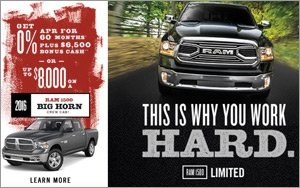automotive
Ram Trucks Win, Slow Process Loses On Automotive Web Sites
- by Karl Greenberg , February 9, 2016
 Everyone loves rich content on a Web site. It’s engaging, intriguing, and fun. But on automobile manufacturer Web sites, rich media can slow the process -- and slow kills, because
auto shoppers seek ease, speed and clarity.
Everyone loves rich content on a Web site. It’s engaging, intriguing, and fun. But on automobile manufacturer Web sites, rich media can slow the process -- and slow kills, because
auto shoppers seek ease, speed and clarity.
According to the J.D. Power 2016 Manufacturer Website Evaluation Study’s winter version, when rich content gets in the way of Web site navigation, especially where rubber hits the road — the automobile-model and configuration pages — satisfaction hits the ditch. And those pages are all important because they are destinations for in-market shoppers.
The study, which measures usefulness of automotive manufacturer Web sites during the new-vehicle shopping process, finds that FCA’s Ram Truck brand does a better job of staying out of the weeds than any other brand. With a score of 838 on a 1,000-point scale, it ranks highest in overall manufacturer Web site satisfaction, followed by Porsche (836) and Mercedes-Benz (828). Lexus, Mini, Audi, BMW, Jaguar, Jeep and Volkswagen top out the top ten. Below the average score of 800 are Dodge, Mazda, Subaru, Lincoln, Chrysler, Nissan, Volvo, Honda, Buick and Chevrolet. Surprisingly, Ford and Toyota are at the very bottom.
advertisement
advertisement
Based on responses from more than 9,500 new-vehicle shoppers who indicate they will be in the market for a new vehicle within the next 24 months, the study takes some serious issues with speed bumps. The number of steps it takes to get where you want to go on a site, whether to view a video or see images, has a negative effect on perception of how fast the site is. The study says 42% shoppers indicate experiencing a problem with speed in at least one area of the Web site. There is 232-point gap in satisfaction between shoppers who experience no speed or navigation issues (845) and those who experience three or more navigation issues and speed issues (613).
Arianne Walker, senior director of marketing analytics at J.D. Power, points out that the Super Bowl is the acid test, since that is the one time, perhaps apart from major product launches, that OEM Web sites are likely to get sacked. “Automakers just spent many millions of dollars on advertising during the Super Bowl to drive a massive amount of traffic to their respective digital showrooms; it’s critical that those Web sites perform at a level consistent with the manufacturer’s brand promise,” she said. “Auto manufacturers need to find the right balance between offering rich content and a robust Web experience that engages shoppers enough to get them to the dealer to take that next step. If the site has difficult navigation and perceived speed issues, shoppers may opt for another brand of interest.”
Among new-vehicle shoppers who say they are “delighted” with their experience on a manufacturer brand website (overall satisfaction scores of 901 or higher), 59% indicate they are more likely to test drive a vehicle after visiting the site, versus only 18% of those who say they are “disappointed” (scores of 500 or below).
The content with which shoppers most often experience slow speed issues includes the build and price tool, videos and interior/exterior 360° images. Site navigation leaves room for improvement: Among the four study measures, navigation and information/content are the least satisfying for shoppers (800 each).




